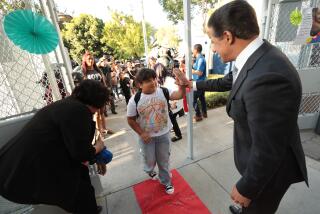Value of Standardized Tests
- Share via
No standardized test is perfect. That includes the Stanford 9, the statewide test used to measure and compare California schools’ progress in teaching language and math. It may test a subject before it is taught. The calibrations may be based on a national sampling that lacks the kaleidoscopic diversity of this state’s public school enrollment.
Those flaws are not good reasons to end standardized testing, which is the most accurate way California has to compare one school with another, one year with another, one teacher with another. An approved motion by the Los Angeles school board to consider alternative forms of evaluation for children who speak limited English won’t halt the Stanford 9 in any case, because the state requires it.
Genethia Hudley Hayes and Jose Huizar, the school board members who proposed the motion, say they question whether a national standardized test like the Stanford 9, on which many low-income black and Latino children do poorly, is the best measure. Four board members this week approved the proposal, and the San Francisco school board is scheduled to vote on a similar motion in June.
The critics of the Stanford 9 are shooting the messenger. Allowing a variety of evaluations could yield scores that resist comparison. Accountability would be lost. Look at the progress in early grades across the state in recent years, lifting rich and poor, native speaker and not. Without standardized testing, who would deliver that good news?
A test linked specifically to academic content in the classroom would provide the most accurate measure of how students are doing. Until California can approve a customized content-based test, however, an off-the-shelf standardized test is necessary.
The federal government also insists on regular testing in school districts that receive federal funds for disadvantaged children. Otherwise, school districts could continue to blow millions of dollars on untrained teachers’ aides, unproven programs and ineffective consultants. When poor and immigrant children get low scores on standardized tests, the results point to areas where they need the most help. Their parents and teachers need a baseline to measure improvement.
The board members also say in their motion that they believe their low-income and immigrant students would do better if they had the best teachers and facilities instead of the most inexperienced teachers, the worst campuses and the most convoluted and disrupted year-round school calendar. Of course. But those conditions would not be affected by a new test.
It is also unfair to lower expectations for poor, minority children by suggesting they can’t get high scores. First-graders in Los Angeles public schools scored above the national average last year. Thousands of children beat stereotypes at schools like Bright Elementary, Martin Luther King Elementary and Barrett Elementary, where standardized test scores are high and rising. Chronic failure at other L.A. schools shouldn’t be blamed on the test.
More to Read
Sign up for Essential California
The most important California stories and recommendations in your inbox every morning.
You may occasionally receive promotional content from the Los Angeles Times.










